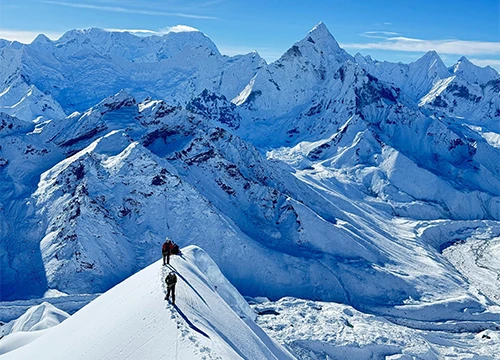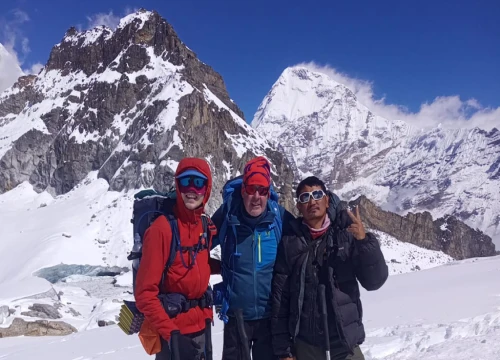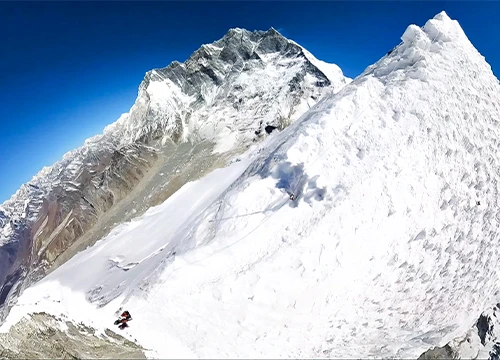Peak Climbing in Nepal
Peak climbing in Nepal is a thrilling sport that takes you to the core of mountains above 5000 meters. It is a fantastic opportunity to summit the Himalayas and enjoy the wilderness of snowcapped peaks. Nepal Mountaineering Association (NMA) has categorized the mountains between 5000-7000 meters as peak climbing in Nepal. Annapurna Region, Everest Region, and Langtang Region are the major peak climbing regions in Nepal. The most popular peaks to climb in the Annapurna region are Chulu West, Chulu East, and Tent Peak. Likewise, Everest Island Peak, Mera Peak, and Lobuche Peak are mostly popular. Furthermore, in the Langtang region, Yala Peak and Naya Kanga Peak are famous among the peak climbers. To climb all these peaks, climbers need to know how to use the gear and equipment.
Iconic Holiday Nepal, we are committed to making your dream into a reality, as our skilled climbers are ready to lead you to some of the highest peaks in Nepal. Skilled, well-trained, and experienced guides who are authorized by the Nepal Mountaineering Association lead our climbing activities. These climbing experts possess technical skills and knowledge of the routes. Your safety, adventure, and satisfaction are a primary concern of Iconic Holiday Nepal.
Most Popular Peak Climbing in Nepal
Mera Peak Climbing:
Mera Peak climbing lies at the edge of the Khumbu region, which offers magnificent views of the five highest peaks in the world. The summit offers views of Mt. Everest, Lhotse, Cho Oyu, Makalu and Kanchenjunga. It takes you to the highest point of 6476 meters, which demands physical and mental strength. Climbing Mera Peak is an excellent opportunity to start your mountaineering journey.
Island Peak Climbing:
Another impressive peak in the Everest region that is suitable for experienced climbers. Island Peak climbing is physically demanding at a height of 6189 meters. Walking through the Ice, rock, and snowy path with rope is never easy for a novice climber. Therefore, Island Peak demands some previous climbing experience and skills to have a remarkable experience.
Lobuche Peak Climbing:
Lobuche Peak is more technical compared to Island and Mera Peak. Lobuche has two climbing routes, Lobuche East and Lobuche West. If you want to experience the challenging and technical route then Lobuche West is the best option. Whereas, Lobuche East is more easy and accessible. It offers panoramic views of the highest peaks such as Mt. Everest, Lhotse, Ama-Dablam, and many more. Lobuche West has a height of 6135m, whereas Lobuche East is 6119m.
Best Time for Peak Climbing in Nepal
The best time to climb peaks in Nepal depends on the region and peak you are climbing. Generally, March-May and September-November are perfect time to climb the peaks. These six months have favourable weather with mild temperatures. However, weather can be unpredictable and there is a high chance of precipitation. Therefore, it is always important to check the weather forecasting before you start peak climbing in Nepal.
Spring Season (March-May)
The temperature during this season ranges between -8 to 10 Degrees Celsius in higher altitudes. Likewise, in the lower regions, it stays between 16 to 23 degrees Celsius. Spring is mostly popular for trekking, peak climbing, and capturing photos.
Autumn Season
During the autumn season in the lower elevation, the temperature is between 10 to 15 degrees Celsius. Likewise, in higher elevations, it is like -12 to 5 degrees Celsius. After the spring season, this is the most suitable time to trek and climb.
Service Charges for Foreign Climber per person in US dollar
Service Charges for Foreign Climbers
Peak Climbing Permit Card
Nepal Mountaineering Association Permit Card
A peak climbing permit is a must if you are planning to climb any peaks in Nepal. You need local area permit card, a restricted area permit card, and a garbage deposit voucher. Iconic Holiday Nepal is here to assist you in arranging the entire necessary permit you need for the climb.
Garbage Deposit Cost
While obtaining the climbing permit, you need to deposit a certain amount of amount as a Garbage Deposit cost. Under the Provision of NMA, the costs will be fully refunded after the completion of the peak climbing. The reason to collect the deposit is to make sure that climbers bring back the garbage and dispose of it after peak climbing.
Local Area Permit Card and Conservation Area Permit Card
Local area permit card includes the Khumbu Region Municipality Permit card during the peak climbing in the Everest region. Likewise, the other permit card you need in the Everest region is the Sagarmatha National Park entry permit. Moreover, in the Annapurna Region, you will need to have an Annapurna Conservation Area Project Permit Card. While in the Langtang Region, a Langtang National Park Permit is required.
Required Documents for Peak Climbing in Nepal:
- Passport size photos
- Copy of your passport
- Application forms
- Travel insurance that includes helicopter charter rescue service


